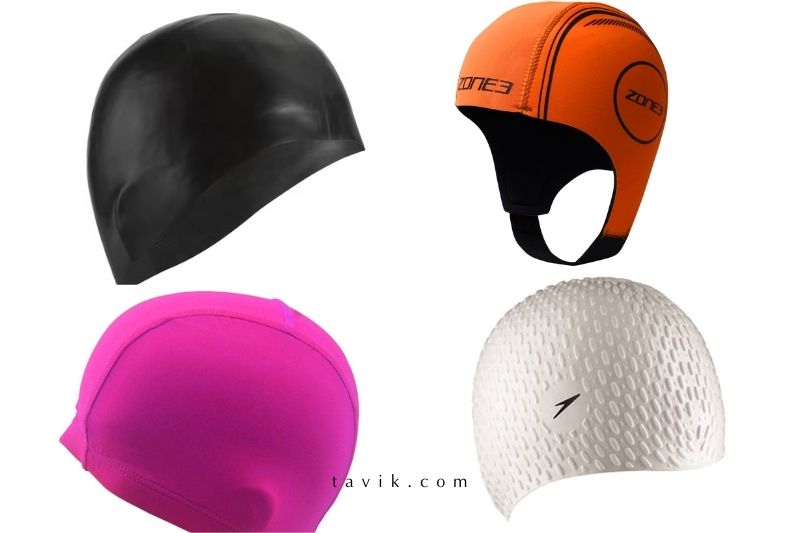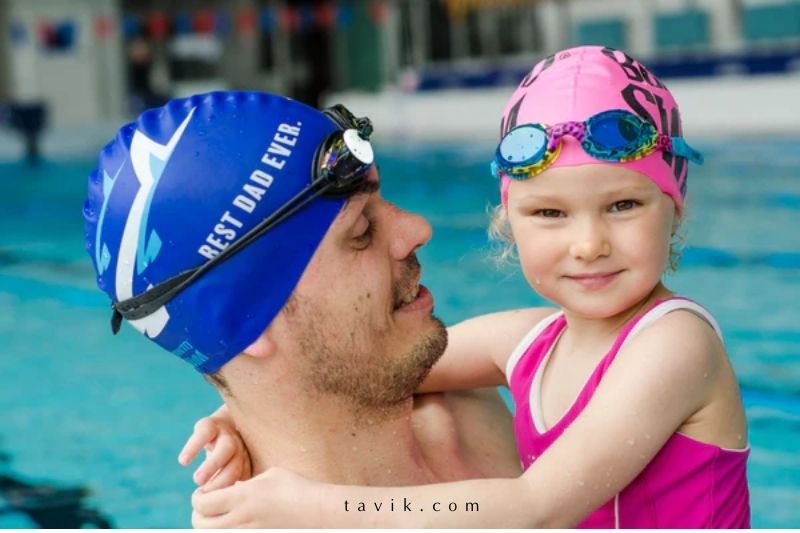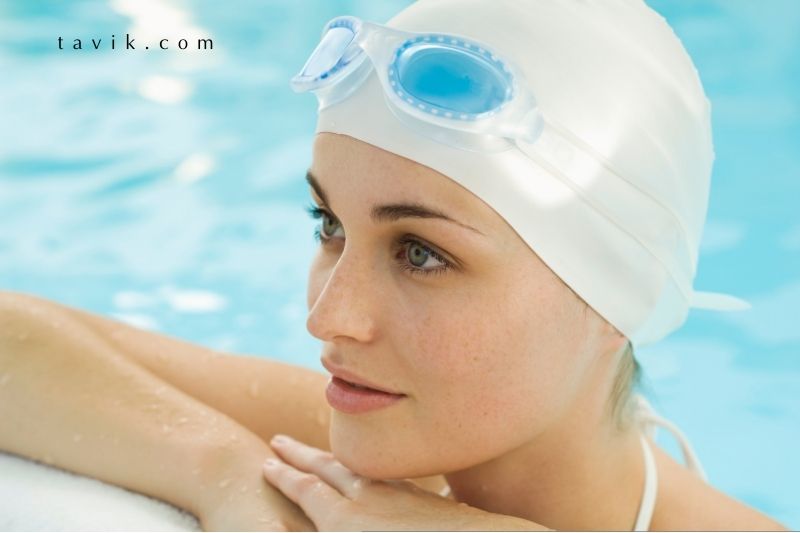How To Put On A Swim Cap? If you're looking for the best ways to put on a swim cap for long hair and short hair, you've come to the right place. In this article, Tavik will give you a step-by-step guide for putting on a swim cap with both long and short hair. We'll also provide some tips on how to keep your hair healthy and protected while swimming.
What is a Swim Cap?
A swim cap is an essential piece of equipment for swimmers. Swim caps may help decrease drag in the water, protect your hair from chlorine damage, and keep loose hair off your face and out of the pool. While it may seem easy, putting this little silicone cap on your head might be difficult if you aren't accustomed to it. To guarantee excellent swimming exercise, ensure the swim cap is secure before entering the water.
Why Wear A Swim Cap?
The following are some of the benefits of wearing a swimming cap: To make you more streamlined in the water: If you compete in swimming, speed is crucial, and your hair will generate water drag, slowing you down. A swimming cap can help you see better while swimming by reducing water drag and keeping your hair out of your face. To prevent your hair from the harmful effects of chlorine, follow these steps: While your hair will still get wet, caps will keep it from being saturated with the chlorinated pool water, which may cause damage. Swimming without a cap causes hair to fall out in the pool, which floats in the water and clogs the filters. Warmth: A swim cap will keep you warm in chilly water if you swim in the open ocean.
Types Of Swim Caps

Silicone Caps
Silicone caps are popular because they are sturdy and durable and provide a sleek and secure fit. If you want a swim cap that will keep your hair somewhat dry, the silicone cap is the way to go since it has a tight fit that prevents water from seeping beneath the cap. Regular swimmers will benefit from silicone caps, whether preparing for their team or swimming for fitness every week. Silicone caps that have been molded are smooth and wrinkle-free, making them more hydrodynamic for competitive swimmers.
Neoprene Caps
Neoprene caps or thermal swim caps are now widely available due to the growing popularity of triathlon and open water swimming. They are meant to keep your head warm when swimming in chilly circumstances. Scuba diving wetsuits are made of neoprene, which allows some water to enter and then holds it close to your body, which warms it up and insulates you. If you swim in open water and need to stay warm, this is a terrific option, but if you swim in a heated pool, we do not suggest a neoprene cap.
Polyester And Lycra Caps
A Lycra or Polyester swim cap is an attractive option if comfort is your first concern. The silky fabric won't pull or grab your hair, and it fits comfortably. Polyester and Lycra caps, on the other hand, are entirely porous, and your hair will get completely wet.
Bubble Caps
Bubble caps are often constructed of latex rubber and have a vintage appearance. These swim caps are ideal for long hair since they have a more spacious fit and are more comfortable than a silicone cap. The bubbles are filled with air, which, combined with the thick rubber material, keeps them warm, making them excellent for open-water swimming. Bubble caps also cover your ears, giving warmth and noise insulation.
How To Put On A Swim Cap With Long Hair And Short Hair?

Method 1: Self-Assembly of a Swim Cap
Tie your hair back.
- Put your hair in a ponytail or bun with a hair tie if you have long hair (depending on the length of your hair).
- Make sure your hair is secure by tying it tightly.
- Because the swim cap may cause your hair to move and pull down, you should knot your hair a bit higher than you'd anticipate it to be in the cap.
Using water from the restroom or changing rooms, wet your hair.
- Dip your head in a water basin, or run your hair under the shower for a few seconds. Wetting your hair helps the cap material slip over your head more easily. Caps have a tendency to cling to dry hair strands and tug them.
- Consider applying a light layer of conditioner to your hair. This will make it much simpler to put the cap on.
Take off your swim cap.
- With your hands, open the swim cap and consider soaking the cap's interior. It is not required to moisten the cap inside, although some individuals have found that doing so makes the cap simpler to put on. With two hands, hold the sides of the swim cap.
- Wetting the cap may make it more challenging to put on, depending on the kind of cap.
Pull the swim cap over your head and secure it.
- Tilt your head down and insert the front of the swim cap between your hairline and brows on your forehead.
- Allow the swim cap to catch at your brow, then pull it down and back with your hands to cover the remainder of your head.
Make any necessary adjustments to the swim cap
- Make any required changes once the swim cap is on your head. Reposition the front of the cap, so it covers your hairline but not your brows, tucking stray hairs inside the cap. After that, wrap the cap over your ears.
- Put on your goggles after pulling the rear of the cap to ensure it is as secure as possible.
- The decision to wear the cap near your ears is mostly a personal taste. Some individuals like wearing a cap covering their ears, particularly while racing. Others choose to cover part of their ears, while others prefer not to cover them.
Method 2: Put on a Swim Cap With A Partner

Tie your hair back.
- If you have longer hair, draw it back and put it in a ponytail or bun with a hair tie.
- Because the swim cap may cause your hair to move, ensure it's pulled up firmly and high.
Make your hair wet
- Before putting on your cap, dip your head in the pool or run it under the shower. Wetting your hair may make it simpler to put on the cap since the material tends to adhere to and pull on dry hair (although this will depend on the material of the cap).
Put on your swimming cap
- Request assistance from a buddy in putting on your swim cap. Tilt your head down while you open the swim cap with your hands. While your companion extends the rear of the swim cap to the back of your head, hold the front of the cap firmly at your forehead.
Make any necessary changes.
- Make any required changes once the cap is on your head. Pull the cap down, even more, adjust the cap's location on your forehead, and tuck any loose hairs in.
- Remember that you may wear the cap over your ears in any manner that feels right. You have the option of tucking your ears in, leaving them out, or covering simply a section of your ears.
Useful Tips For Putting On Swim Cap

1. It's Not A Good Idea To Have Dry Hair
Swim cap fabrics, as you may well know, scape more readily across wet surfaces. Because these materials are generally latex or silicone, it's easy to see why putting a cap on without first lubing it up is a terrible idea. If you're wondering how to put on a swim cap with dry hair, the best advice is to just don't attempt; you'll wind up tearing a lot of hair strands out, which is both uncomfortable and pointless. Instead, moisten your mane a tiny bit before you start so you can get used to it. You don't have to go full-on shower head, but the water should be wet enough for the cap's material to move quickly. You'll notice that putting on a swimming cap is a lot simpler, and the cap will go smoothly down your head. If you add a little conditioner to the mix, your hair will be much smoother, and the scaping action will be much better. You'll have more time and less pain on your hands if you wet your hair and apply a little conditioner.
2. Make a bun out of it
Hair is the primary component that goes beneath your swim cap. Therefore it's also the one that's most likely to cause problems when it's time to put it on. It's a good idea for persons with longer hair, mainly ladies, to tie it up before attempting to slip the swimming cap down their heads. Trying to cram every strand of hair into the cap randomly is a bit of a disaster, not to mention inefficient. It doesn't matter whether it's braided, twisted, or just put up in a bun; as long as it's appropriately knotted and there aren't any stray strands, it should be alright. If your hair is long enough to need some type of restraint, the only thing you should be careful of is using bobby pins or other pointy accessories. These may easily tear your cap, so be cautious!
3. Extend it as far as you can
After you've done the necessary preparations, it's time to learn how to put on a swimming cap. The first step is to stretch it as broad as possible but not to the point of shredding it. Pull both sides aside as far as you can within acceptable bounds, using the backs of your hands. If you want a better idea of what you're doing, you can always stand in front of a mirror and check sure you're stretching correctly. Plus, instead of tugging at eye or chest level, do it with the cap and hands already on top of your head. You'll be able to compare the cap size as you stretch it to see whether it's broad enough to go through your head comfortably without leaving any hair strands behind.
4. Make your way through
You're ready to drop your cap down your head now that you've stretched it to a decent amount. This should be pretty straightforward, thanks to all prior preparations, particularly having wet and conditioned your hair. Some individuals find it easier to slip the cap through their heads by bending over, so you may quickly test whether or not this works for you. Regardless of your position, you must move the swimming cap in the direction of your head and ensure that the inner front contacts your head. Then, in one rapid motion, pull it back until it completely encircles your head, bringing it down. Take your hands out of the back pocket and examine your nails closely (having long fingernails is not a good idea it can make the process harder). Things are more likely to go wrong at this point, and you may need to remove the cap and start all over. Don't worry; it's preferable to have it neatly closed and correctly positioned in the water than to go in it and be uncomfortable while swimming.
5. Make any necessary adjustments
It's now time to make the necessary alterations to the swimming cap. Your swimming cap will unlikely be correctly placed on the first time, no matter how meticulous you were with the preparations. This is mainly because there are always a few stray hair strands that get in the way, either because you didn't tie them firmly enough or because they are too short to remain in place. It's not a huge deal either way; just make sure any stray hair you discover is placed under the swimming cap and fastened, whether at the front of your head or on the nape of your neck. When tucking these loose strands in, try to close the cap as securely as possible. This will keep any water out of your house while swimming and having a good time.
6. Enlist a little assistance on the side
Putting on a swimming cap gets a hundred times simpler if you ask for a little more assistance, as it does with most things in life. Having a friend, family member, or team member nearby may help you save time and make the procedure go more smoothly. You may, for example, have someone extend the swimming cap over your head and slip it through your hair while you fix it neatly and firmly, or you can do the reverse. This would include having someone hold your hair down while you merely have to extend and scape the cap down the whole length of your head. You'll save a lot of time straightening and arranging your loose hair strands, and there's a far better chance you'll be ready to leave right away! This is very useful for parents since youngsters often run about aimlessly to get into the water. Typically, youngsters attempt to put on the swimming cap themselves, which results in a less-than-pleasant appearance - and is likely unpleasant for them!
7. Determine the temperature of your water.
When wearing a swim cap, you should be highly aware of the temperature of the water you will be swimming in. Investing in a sturdy swim cap, such as a silicon-based swim cap, is one of the most delicate things you can do. You'll want to be sure your swim cap can withstand various temperatures for peace of mind and long-term durability. If a cap is constructed of a thick enough material, it may soon cause the body to overheat. When swimming or standing in water for lengthy periods, thicker fabrics provide little space for heat dispersion and may be uncomfortable. Silicon was created to be able to withstand very high temperatures. This strong material can endure higher temperatures than other materials while still giving you the protection and covering you want.
8. Understand how to take care of your swimming cap
It's not rocket science to figure out how to wear hair under swim cap; it's more a matter of picking up a few pointers and practicing. Eventually, it'll become second nature. However, you should consider the health of your cap and the ideal way to wear it. Swimming caps that are well-kept are likely to perform better than those that aren't, and the act of scaping them on your head is generally when the most significant harm occurs. Ensure you're not ruining your swimming cap when you put it on. Take care, particularly while extending it and with your nails. If you're wearing any rings or earrings, or if the person assisting you in putting on the cap is, take them off or ask them to take them off, so the sharp things don't damage the cloth. Cap health is crucial, so don't overlook it!
Hair And Caps Protection
 Unless you have discovered a swim cap that fits you properly and seals well, you will have damp patches on your hair after swimming. If you want to prevent chlorine from getting into your swim cap, damp your hair beforehand in the shower before putting it on. You may prevent chlorine from leaking beneath your cap by filling and sealing the hair shafts. Before putting on a swim cap, some individuals condition their hair, but this might cause the cap to pop off. It should keep it from rising if you wear goggles over your cap. If you brush the conditioner through your hair beforehand, ensure you're wearing a cap that seals well to keep the conditioner out of the pool. Suppose you prefer to swim without a cap. In that case, we recommend rinsing your hair in the shower before swimming and then rinsing it thoroughly afterward with shampoo and conditioner to help heal any chlorine damage. We recommend using a deep conditioning treatment once a week if you swim regularly. After each usage, rinse your swimming cap in cold water, dry it to extend its life, and maintain it in excellent shape. Avoid exposing your swim cap to direct sunlight for lengthy periods, and avoid puncturing it with sharp items such as hair clips and pins.
Unless you have discovered a swim cap that fits you properly and seals well, you will have damp patches on your hair after swimming. If you want to prevent chlorine from getting into your swim cap, damp your hair beforehand in the shower before putting it on. You may prevent chlorine from leaking beneath your cap by filling and sealing the hair shafts. Before putting on a swim cap, some individuals condition their hair, but this might cause the cap to pop off. It should keep it from rising if you wear goggles over your cap. If you brush the conditioner through your hair beforehand, ensure you're wearing a cap that seals well to keep the conditioner out of the pool. Suppose you prefer to swim without a cap. In that case, we recommend rinsing your hair in the shower before swimming and then rinsing it thoroughly afterward with shampoo and conditioner to help heal any chlorine damage. We recommend using a deep conditioning treatment once a week if you swim regularly. After each usage, rinse your swimming cap in cold water, dry it to extend its life, and maintain it in excellent shape. Avoid exposing your swim cap to direct sunlight for lengthy periods, and avoid puncturing it with sharp items such as hair clips and pins.
How To Use Swimming Cap - FAQs
1. Will A Swim Cap Keep Hair Dry? Will Wearing Two Swim Caps Keep Hair Dry?
No, I'm afraid not. Swim caps aren't meant to keep your hair dry; they're meant to decrease drag and keep you clean. Silicone caps, or wearing two caps together with a silicone one on top, do, however, provide an excellent seal that keeps a lot of water out. A swim cap will protect your hair from splashes and keep it dry if you swim without placing your head in the water. Still, if you swim with your head below the water line, water will leak into the cap due to the lack of a watertight seal.
2. Are there various sizes of swim caps?
Most swim caps are one size; others are available in several sizes, such as small, medium, and large; these are usually racing caps or open water neoprene caps. Many swim cap companies make caps for adults and youngsters, with the latter being smaller.
3. I have a huge head and lengthy hair. Will a regular swim cap work?
Long hair caps, such as those from Speedo and Zoggs, are available with a roomier fit to accommodate long hair. Bubble caps are also a decent option for longer hair and more giant heads; however, they can generate heat, so if you're a competitive swimmer, they could be too hot.
4. Do swim caps protect your ears by covering them and preventing water from entering the ear?
The Aqua Gcape Swim Cap from Aqua Sphere contains ear pockets that provide a secure fit over your ears and a decent seal to keep most water out. Still, it cannot ensure that no water will sneak in. Bubble caps may also cover the ears; however, since swim caps do not provide a watertight seal, water may still enter the ears. Carol Swim is an example of a product you may utilize.
Conclusion
There are a few different ways to put on a swim cap, but some are better than others, depending on the length of your hair. If you have short hair, it's best to put the swim cap on by pulling it over your head and tucking your hair underneath. If you have long hair, you can either put the swim cap on by tucking your hair underneath or by putting your hair in a bun and then pulling the swim cap over your head. Thank you for reading!

